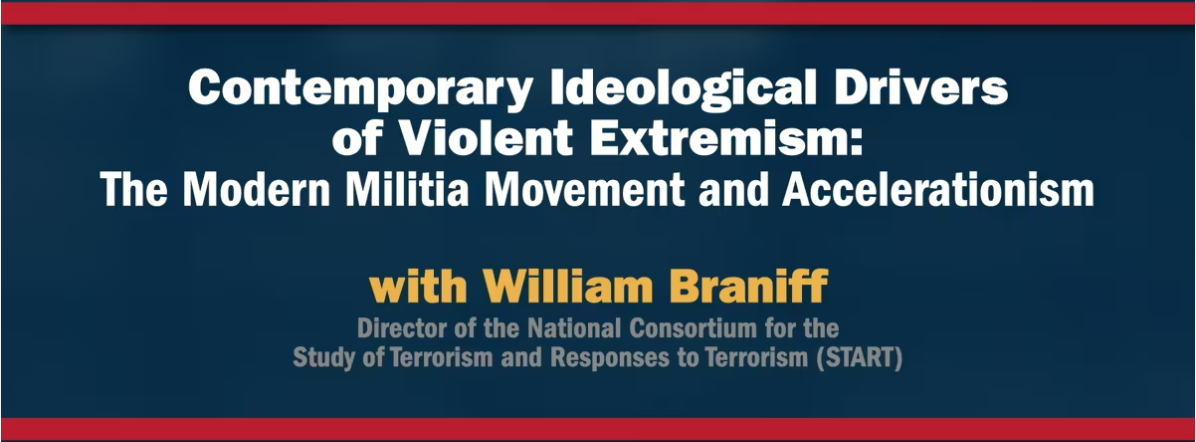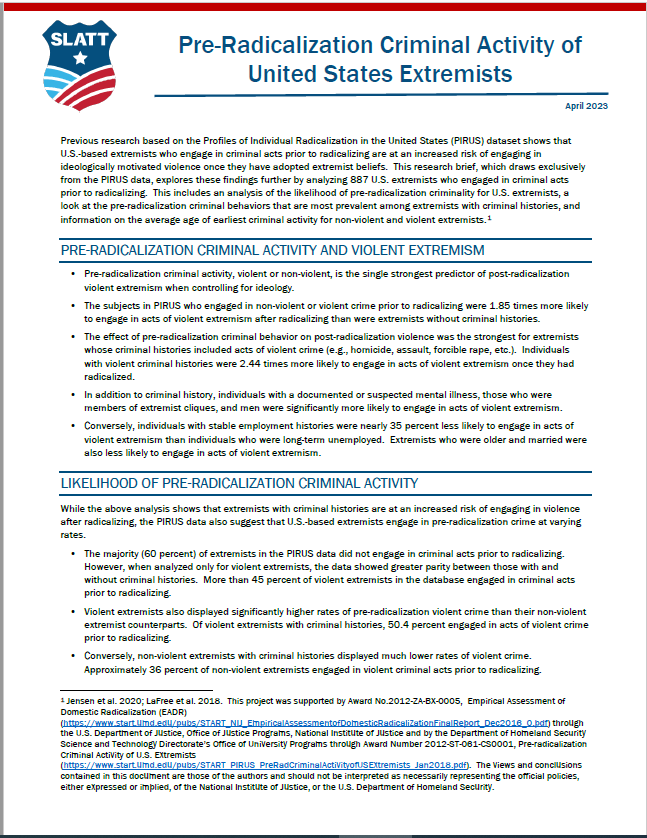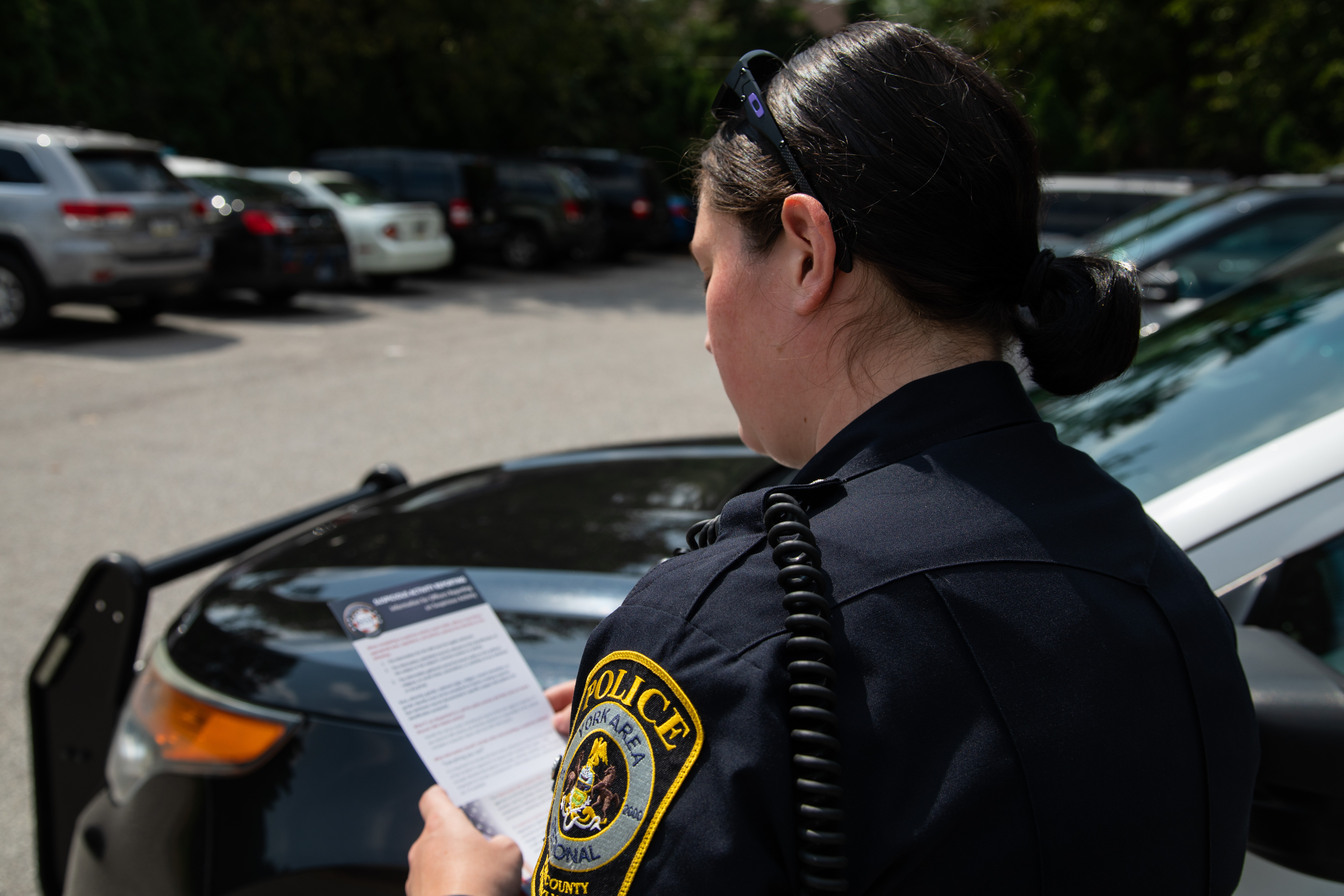The SLATT Program supports state, local, tribal, and territorial law enforcement officers and criminal justice, homeland security, and mission-critical partners with a vast array of resources, including videos, recorded lectures, and on-demand web events that highlight current research, national trends, and subject-matter expert perspectives regarding terrorism and targeted violence prevention. SLATT resources are multiuse and suitable for individual officers during roll call or larger group settings, including basic academy and in-service training. They are also suitable for a broad base of professionals, including private and public sector security personnel, emergency management, and prosecutors.
SLATT resources are limited to sworn law enforcement, support staff, and approved criminal justice and public safety users.
Please utilize your approved account, your LEEP, or your RISS credentials to access resources.
Trends in Unmanned Aerial Vehicles (UAVs) and Their Implications for Law Enforcement
Document

Topic
NEW!, Executives/Managers, Line Officers, All Resources, Analysts and InvestigatorsLength
6 pages
The publication, “Trends in Unmanned Aerial Vehicles (UAVs) and Their Implications for Law Enforcement” outlines the evolution of UAVs from recreational and commercial devices to tools increasingly used by malicious actors. It highlights the three most common criminal and terrorist applications of UAVs and discusses key technological advancements that will further enhance their capabilities.
Generative AI in Law Enforcement - A Revolutionary Tool Fraught with Complex Challenges
Document

Topic
NEW!, Executives/Managers, Line Officers, All Resources, Analysts and InvestigatorsLength
7 pages
The publication, “Generative Artificial intelligence in Law Enforcement: A Revolutionary Tool Fraught with Complex Challenges” discusses the transformative potential of Generative AI in law enforcement. It highlights how the technology could revolutionize operations through task automation, large-scale data analysis, and enhanced predictive policing. However, it also emphasizes the substantial ethical, societal, and regulatory concerns that accompany its use, as well as the risk of misuse by criminals. The publication stresses the need for law enforcement to carefully balance the benefits of GenAI with a cautious, risk-aware approach as adoption grows.
Law Enforcement Interdiction of Extremist Plots
Document
Topic
Privacy, Civil Rights, and Civil Liberties, Executives/Managers, Line Officers, All Resources, Analysts and InvestigatorsLength
11 Pages
Law Enforcement Interdiction of Extremist Plots - provides an analysis of the mobilization indicators identified in the Nationwide Suspicious Activity Reporting (SAR) Initiative (NSI) that were present in the plots, as well as the law enforcement interdiction strategies used to disrupt them.
An Overview of the Profiles of Individual Radicalization in the United States (PIRUS)-Plots Database
Document
Topic
Privacy, Civil Rights, and Civil Liberties, Executives/Managers, Line Officers, All Resources, Analysts and InvestigatorsLength
8 Pages
An Overview of Profiles of Individual Radicalization in the United States-PLOTS - provides a broad overview of the PIRUS-Plots data, including sections on plot locations, types, and outcomes; comparisons of plots across ideological types; and patterns in weapons, targets, and perpetrators.
SLATT Webinar - How to Build a Threat Assessment Threat Management Team
Video

Topic
All Resources, Webinar RecordingsLength
1:41:36
The presentation focused on the key concepts and requirements for building scalable threat assessment threat management teams (TATMs) as a means of preventing or mitigating the risk of targeted violence. Delivered by subject-matter experts leading TATM prevention efforts within their law enforcement organizations, the webinar builds on the concept of TATMs as an evolving solution to targeted violence. Utilizing case studies, the presentation details how to build scalable TATMs, while also addressing the challenges and lessons learned from both a law enforcement and clinical perspective.
Emerging Technology Primer
Document

Topic
Executives/Managers, All Resources, Analysts and InvestigatorsLength
6 pages
Emerging technology describes a technology that has just come on, or is about to come on, the horizon. When considering how emerging technologies (or any technology) might be used in harmful ways, it is important to differentiate them as adjunct and disruptive technologies. Some technologies are explicitly adjunct or disruptive, while others may be categorized as either adjunct or disruptive, depending on how they are utilized by the user. This publication provides examples of technologies categorized as adjunct and/or disruptive, as well as illustrating where, along the emerging/mature technology continuum, each technology approximately lies as of the date of this publication.
Profiles of Individual Radicalization in the United States (PIRUS)
Document
.JPG)
Topic
All Resources, Analysts and InvestigatorsLength
4 Pages
PIRUS is a database of 3,203 Islamist, far-left, far-right, and single- issue extremists who have radicalized to violent and nonviolent extremism in the United States from 1948 through 2021. The National Consortium for the Study of Terrorism and Responses to Terrorism (START) defines extremism as the use of illegal means, including violence, in the pursuit of political, economic, religious, or social goals. The PIRUS database is based entirely on open-sources and is freely available for download on START’s webpage at https://www.start.umd.edu/data-tools/profiles-individual-radicalization-united-states-pirus. The analysis for this research brief draws on the full dataset and illustrates the important differences that exist across ideological groups, as well as those which distinguish violent from non-violent extremists.
Considerations for Classifying Hate Crime Offenders
Document

Topic
All Resources, Analysts and InvestigatorsLength
5 Pages
The Bias Incidents and Actors Study (BIAS) is a multi-method project conducted by the National Consortium for the Study of Terrorism and Responses to Terrorism (START), and funded by the U.S. Department of Justice, Office of Justice Programs, National Institute of Justice, that examines the characteristics, motivations, and behaviors of a sample of individuals who committed hate crimes in the United States from 1990–2018. The project includes a dataset of 689 violent and 277 non-violent hate crime offenders who were motivated by bias based on (1) race, ethnicity, and/or nationality; (2) religion; (3) sexual orientation, gender, or gender identity; (4) age; or (5) disability. Individuals included in the dataset were randomly selected from a pool of potential subjects who were reviewed according to the project's inclusion criteria and minimum information requirements. The dataset contains more than 100 variable fields with information on hate crime events, victim characteristics, and offender motivations, demographics, and personal histories.
SLATT Webinar - Threat Assessment Threat Management Overview for Law Enforcement Executives
Video

Topic
Executives/Managers, All Resources, Webinar RecordingsLength
1:28:02
This presentation focuses on the importance of threat assessment and threat management (TATM) teams as a means of preventing or mitigating the risk of targeted violence and it suitable for law enforcement leaders who are contemplating the creation of TATM teams in their judications, and for criminal justice personnel seeking to increase their knowledge of TATM concepts as a means of protecting their communities. Delivered by a State and Local Anti-Terrorism Training (SLATT) subject-matter expert and retired Federal Bureau of Investigation (FBI) special agent with years of experience leading the FBI's Behavioral Threat Assessment Center, the webinar is organized into sex key topical areas that include an introduction, an overview of the evolving challenge, the evolving solution, core pillars for successful TATM teams, key take-aways, and an open discussion and conclusion. This webinar is part of the Bureau of Justice Assistance (BJA) SLATT Program's continued effort to prepare law enforcement officers and criminal justice practitioners to ethically identify, investigate, prevent, and respond to acts of terrorism, targeted violence, and hate crimes. The intended audience for this no-cost web event are law enforcement and criminal justice leaders. Mental health, emergency management, first responders, and personnel with a homeland security-related mission are also welcome to attend.
Contemporary Ideological Drivers of Violent Extremism: Updating the Hate Crime Perpetrator Typology
Video

Topic
All Resources, Analysts and InvestigatorsLength
6:38
Hate crime is a more common form of ideologically motivated violence in the United States than is terrorism, yet researchers have dedicated less attention to the perpetrators of hate crime. This lecture updates a popular but dated hate crime offender typology with the goal of helping the law enforcement community to better conceptualize and anticipate hate crime.
Contemporary Ideological Drivers of Violent Extremism: Anarchism, Anti-Capitalism, and Anti-Fascism
Video

Topic
All Resources, Analysts and InvestigatorsLength
4:58
Violent extremism comes in many different forms in the United States, and while authorities should prioritize the most lethal and active forms, it is also important to understand other forms of violent extremism. This lecture provides an overview of three related ideological drivers of criminal extremism in the United States—anarchism, anti-capitalism, and anti-fascism—with a focus on anti-fascism, a topic of popular attention in recent years.
Contemporary Ideological Drivers of Violent Extremism: The Modern Militia Movement and Acceleration
Video

Topic
All Resources, Analysts and InvestigatorsLength
5:49
Violent extremist movements quickly evolve, often in part to unpredictable online discourse. This lecture focuses on one example of how an ideological innovation—accelerationism—helped increase the prevalence of revolutionary ideology among militia extremists.
Contemporary Ideological Drivers of Violent Extremism: The Great Replacement Theory
Video

Topic
All Resources, Analysts and InvestigatorsLength
5:55
At any given time, a violent extremism movement will advance justifications for criminal violence based on combinations of old and new ideas. This lecture focuses on explaining an important contemporary variation of a white supremacist justification for violence, referred to as the Great Replacement Theory.
Pre-Radicalization Criminal Activity of United States Extremists
Document

Topic
All Resources, Analysts and InvestigatorsPrevious research based on the Profiles of Individual Radicalization in the United States (PIRUS) dataset (https://www.start.umd.edu/data-tools/profiles-individual-radicalization-united-states-pirus) shows that U.S.-based extremists who engage in criminal acts prior to radicalizing are at an increased risk of engaging in ideologically motivated violence once they have adopted extremist beliefs. This research brief, which draws exclusively from the PIRUS data, explores these findings further by analyzing 887 U.S. extremists who engaged in criminal acts prior to radicalizing. This includes an analysis of the likelihood of pre-radicalization criminality for U.S. extremists, a look at the pre-radicalization criminal behaviors that are most prevalent among extremists with criminal histories, and information on the average age of earliest criminal activity for non-violent and violent extremists.
QAnon Offender in the United States
Document

Topic
All Resources, Analysts and InvestigatorsLength
5 Pages
As of September 22, 2021, 101 QAnon followers have allegedly committed ideologically motivated crimes in the United States. This includes two offenders who were inspired by the PizzaGate conspiracy, a precursor to QAnon, who committed crimes in 2016, and 61 individuals who participated in the Capitol insurrection on January 6, 2021. The offenders come from 34 states, including 16 from California, 10 from Texas, and 6 from Florida. Using auxiliary data from the Profiles of Individual Radicalization in the United States (PIRUS) project, these infographics provide information on the characteristics of U.S. QAnon offenders and their crimes. While QAnon is a broad conspiracy theory with many elements, it is centered around the belief that a cabal of democratic politicians, international elites, and Hollywood celebrities are engaged in a global child sex trafficking ring. (Source: National Consortium for the Study of Terrorism and Responses to Terrorism (START), 2023, retrieved from Profiles of Individual Radicalization in the United States.)
SLATT - Vehicles as Contact Weapons in Terrorist Attacks
Document

Topic
All Resources, Analysts and InvestigatorsLength
5 Pages
This publication provides a statistical analysis of events categorized as terrorist attacks in the Global Terrorism Database (GTD), an open-source information repository collected by researchers at the National Consortium for the Study of Terrorism and Responses to Terrorism (START), at the University of Maryland. It is not a threat or vulnerability assessment of vehicles as contact weapons more generally. Many vehicle ramming events that have taken place in the context of protest-related violence do not meet the definition of terrorism as outlined in the GTD.
American Deaths in Terrorist Attacks 1995 - 2019
Document

Topic
All Resources, Analysts and InvestigatorsLength
2 Pages
The document presents statistics on the total number of international and domestic terrorist attacks that took place in the United States, the total number of deaths due to international and domestic terrorist attacks in the United States (including perpetrators), and the total number of American deaths due to terrorist attacks worldwide (including perpetrators, and excluding deaths in Afghanistan and Iraq), from 1995 to 2019
SLATT Quick Links
Document

Topic
Executives/Managers, Line Officers, All Resources, Analysts and Investigators, Quick LinksLength
4 Pages
This document is a list of entities or resources that law enforcement can utilize to combat terrorism, targeted violence, and hate crimes.
Webinar - Violent Extremism in the Digital Front
Video

Topic
All Resources, Analysts and Investigators, Webinar RecordingsLength
1:20:33
One of law enforcements primary goals is to detect, interdict, and prevent violence. The collection and analysis of social media and Internet-Based communications present interdiction and detection opportunities to prevent terrorism and targeted violence.
SLATT PROTECT Resource Document
Document

Topic
Line Officers, All ResourcesLength
2 Pages
SLATT PROTECT Resource Document contains links provided during the SLATT PROTECT virtual course which is intended for patrol and frontline officers.
Domestic Extremism in the United States
Document

Topic
All Resources, Analysts and InvestigatorsLength
4 Pages
In this brief, we define and operationalize relevant terms, and identify and describe the major domestic extremist movements in the United States today, illustrating how extremist actors mobilize in the context of broader movements and organizational networks.
SLATT PREPARE Resource Document
Document

Topic
Executives/Managers, All ResourcesDesigned for law enforcement executives and managers to enhance agency threat detection and response capability to violent extremism, while enabling community trust through transparency and accountability.
SLATT Resources
Document

Topic
Executives/Managers, All ResourcesLength
1 Page
SLATT program resource links for SLATT website, training, resources, new user, contact us, Bureau of Justice Assistance (BJA), and upcoming training.
State and Local Anti-Terrorism Training (SLATT) Program Overview
Document

Topic
Executives/Managers, Line Officers, All Resources, Analysts and InvestigatorsLength
2 Pages
The SLATT Program addresses the prevention of terrorism, targeted violence, and hate crime by providing no-cost and role-based training, resources, and technical assistance to state, local, tribal, and territorial (SLTT) law enforcement officers and agencies.
Defining and Operationalizing Targeted Violence
Document

Topic
All Resources, Analysts and InvestigatorsLength
4 Pages
In September 2019, the U.S. Department of Homeland Security (DHS) published its Strategic Framework for Countering Terrorism and Targeted Violence, highlighting the importance of considering acts of “targeted violence” when developing plans and strategies for promoting national security.
Extremism and Hate Crime in the United States: Examining Evolving Threats
Document

Topic
All Resources, Analysts and InvestigatorsLength
5 Pages
This research brief, developed by the National Consortium for the Study of Terrorism and Responses to Terrorism (START) on behalf of the State and Local Anti-Terrorism Training (SLATT) Program, is designed to familiarize readers with the characteristics of United States extremists and hate crime offenders. Using data from the Profiles of Individual Radicalization in the United States (PIRUS) database and the Bias Incidents and Actors Study (BIAS), this brief explores the characteristics of U.S. hate crime offenders, trends in target patterns and outcomes of violent plots, and the demographic and risk factors of U.S. extremists and hate crime offenders. Each section of the brief also explores the relevant criminal justice implications of the data and trends.
Theories of Radicalization
Document

Topic
All Resources, Analysts and InvestigatorsLength
3 Pages
This brief will address theories of radicalization and some implications for law enforcement (LE) officers.
Webinar - SLATT 2022
Video

Topic
Executives/Managers, All Resources, Webinar RecordingsLength
47:39
A discussion of the SLATT Program and an introduction to the team tasked with the development of a suite of no-cost, on-site, virtual, and eLearning training courses to prepare state, local, tribal, and territorial law enforcement officers and agencies to ethically identify, interdict, prevent, and respond to acts of terrorism, targeted violence, and hate crime.
Webinar - Understanding the Characteristics and Motivations of U.S. Hate Crime Offenders
Video

Topic
All Resources, Analysts and Investigators, Webinar RecordingsLength
1:03:27
Hate crimes appear to be on the rise in the United States and while research on bias crime has grown considerably since the passing of the Hate Crime Statistics Act of 1990, comparatively little has been written about the criminal trajectories and pathways of bias crime offenders. Dr. Mike Jensen, PhD, Radicalization and Disengagement Portfolio Lead of the National Consortium for the Study of Terrorism and Responses to Terrorism (START) speaks to the hate crime trends regarding motivations, target patterns and risk factors for violent hate crime offenders and mass casualty hate crime offenders.
COVID-19 and Violent Extremism
Document

Topic
All Resources, Analysts and InvestigatorsLength
3 Pages
The extended nature of the COVID-19 global pandemic has raised multiple concerns related to the prevalence and nature of violent extremism in the United States. First, the impacts of the pandemic (including social isolation and economic dislocation) have been hypothesized to increase individual vulnerabilities to radicalization, which extremist actors have been mobilizing to exploit. Second, extremist actors have incorporated COVID-19 into their existing narrative frameworks, seeking to direct blame attribution and inflame grievances arising from responses to the pandemic. Finally, the pandemic and responses to the pandemic may shift the behavior of violent extremists. This brief will review each of these intersections between COVID-19 and violent extremism.
Characteristics and Targets of Mass Casualty Hate Crime Offenders
Document

Topic
All Resources, Analysts and InvestigatorsLength
4 Pages
The Bias Incidents and Actors Study (BIAS) is a multi-method project conducted by the National Consortium for the Study of Terrorism and Responses to Terrorism (START) that examines the characteristics, motivations, and behaviors of a sample of individuals who committed hate crimes in the United States from 1990-2018.
Webinar - Changing Landscape of Terrorism and Violent Extremism
Video

Topic
All Resources, Analysts and Investigators, Webinar RecordingsLength
59.37
Violent extremism changes over time. Motivations and ideologies increase or decrease in prevalence, interact with the information environment in new and different ways, and generate violence featuring different weapons, tactics, and targets. Appreciating the changing threat landscape allows our professional law enforcement community to remain nimble, anticipate organizational needs, and foster relationships that will be most effective in protecting the public. Listen to Mr. Bill Braniff discuss the changing threat landscape of terrorism and violent extremism. Mr. Braniff is the Director of the National Consortium for the Study of Terrorism and Responses to Terrorism or START, and a Professor of the Practice at the University of Maryland. He previously served as the director of practitioner education at West Point’s Combating Terrorism Center (CTC) and an instructor in the Department of Social Sciences. Mr. Braniff is a graduate of the United States Military Academy and the Johns Hopkins School of Advanced International Study.
You Can Save Lives
Hyperlink

Topic
Line Officers, All ResourcesActs of terrorism and violence can happen anytime. This infographic tells you the steps you can take to be prepared to prevent acts of terrorism and targeted violence.
eGuardian: A Resource for Law Enforcement
Audio

Topic
All Resources, Analysts and InvestigatorsLength
12:57
In this podcast, Senior Law Enforcement Advisor with the FBI Office of Partner Engagement Shawn Turonis shares the functionality of the data-sharing platform eGuardian. Shawn talks with Monte McKee, a SLATT Program facilitator and lead instructor, concerning the purpose of eGuardian, how the application works across federal and local law enforcement, and why it is considered an asset to law enforcement task forces.
Understanding the Pathway to Violence
Audio

Topic
Line Officers, All ResourcesLength
7:07
It’s important for officers in the field to understand the pathway to violence. This lecture discusses the importance of understanding four critical steps that build the pathway to violence, and the significance of how the nature of an officer’s job may place that officer within the timeline of a subject who is planning targeted violence.
Sharing Information and Intelligence to Promote Counterterrorism
Audio

Topic
Privacy, Civil Rights, and Civil Liberties, Executives/Managers, All ResourcesLength
4:45
It is critical that threat information be shared not only to strengthen officer safety capabilities but also to inform those that may have the opportunity to cross the timeline of potential threat actors. This lecture discusses the importance of sharing threat information needed to promote counterterrorism and describes the safeguards needed to protect privacy, civil rights, and civil liberties.
How Can Crime Gun Intelligence Assist in Counterterrorism Efforts?
Audio

Topic
All Resources, Analysts and InvestigatorsLength
7:46
Crime gun intelligence can be a great enabler for law enforcement organizations who investigate violent acts where a firearm is used because it can provide context, visualization of the criminal environment, and a common operating picture for stakeholders to share information and collaborate. This lecture discusses the importance of understanding what crime gun intelligence is and how it plays a role in the overall investigation of terrorism events.
Leveraging Intelligence to Influence Decision Making
Audio
.jpg)
Topic
Line Officers, All ResourcesLength
5:36
Officers should have an understanding of how to utilize sound threat intelligence as a component in their decision-making process while remaining in line with capabilities and available resources. This lecture discusses the importance of leveraging threat intelligence as a consideration in decision-making while not making it protocol or policy.
How to be a Good Intelligence Consumer in the Field
Audio

Topic
Line Officers, All ResourcesLength
6:27
Threat intelligence can increase officer safety capabilities while, at the same time, safeguard communities. This lecture discusses how to utilize the local intelligence center to receive threat intelligence to develop a greater understanding of criminal or violent extremist groups operating in your jurisdiction.
What Is Threat Reporting?
Audio

Topic
Line Officers, All ResourcesLength
4:48
Threat reporting delivers the context, indicators, implications, and, most importantly, actionable guidance regarding current and emerging threats. This lecture discusses threat reporting and how line-level personnel can familiarize themselves with understanding threat reporting to leverage it toward increasing officer safety and further safeguarding their communities.
The Role of Fusion Centers in Counterterrorism
Audio

Topic
Executives/Managers, All ResourcesLength
6:44
Fusion centers fulfill a vital need for sharing intelligence information between the intelligence community and state and local authorities. This lecture discusses the relationship between fusion centers and state and local law enforcement agencies and how fusion centers serve to assist in interpreting the environment for their constituents.
The Value of Intelligence and Analysis Towards Understanding Threats
Audio

Topic
Line Officers, All ResourcesLength
7:28
Intelligence is about understanding problems. Real intelligence is about being able to do something about those problems for which we now understand. This lecture discusses the purpose of using intelligence in the field to better understand the threats of terrorist activities and the idea that intelligence and analysis are critical components of counterterrorism efforts for line officers.
Thinking About Terrorism From a Line Officer's Perspective
Audio

Topic
Line Officers, All ResourcesLength
8:26
We want to ensure that officers in the field have an understanding of the terrorist threats posed against them by leveraging existing intelligence and intelligence processes available to them. This lecture introduces the different ways to define terrorism and considerations for recognizing the different types of terrorism.
Terrorism and Counterterrorism 101
Video

Topic
All Resources, Analysts and InvestigatorsLength
37:48
As a law enforcement professional, you are tasked with countering terrorism. You cannot counter a threat without being fully aware of its nature and how it operates. This video will discuss factors that enable terrorism, an overview of trends, considerations for law enforcement, and further resources.
Radicalization and Mobilization
Video

Topic
All Resources, Analysts and InvestigatorsLength
33:28
Why is it important to understand the radicalization of beliefs and mobilization? This video defines radicalization of beliefs and mobilization and discusses the importance of understanding the radicalization and mobilization process.
Post-Prison Reintegration
Video

Topic
All Resources, Analysts and InvestigatorsLength
5:24
Counterterrorism does not end when an individual violent extremist is arrested and incarcerated. It delays the threat posed by the individual but does not necessarily minimize the risk to public safety over time. For real risk reduction, rehabilitation and reintegration of violent extremists are necessary. This video discusses barriers to reintegration and the implications for law enforcement.
Low-Tech Attacks
Video

Topic
All Resources, Analysts and InvestigatorsLength
7:39
The average terrorist attack targeting the United States is low-tech, employing readily available weapon systems such as firearms, vehicles as contact weapons, and explosive devices. This video discusses why low-tech attacks are so prevalent, suspicious activities that may precede an attack, and more related to low-tech attacks.
Low-Dollar Terrorism
Audio

Topic
All Resources, Analysts and InvestigatorsLength
33:38
Listen to Mr. Chris Griggs, a SLATT Program curriculum lead, talk with Lieutenant Colonel Ray Guidetti, retired deputy superintendent of investigations for the New Jersey State Police, as they discuss the emergence of low-dollar terrorism, the role social media plays in spreading low-dollar terrorism, and the steps law enforcement agencies can take to reduce this threat.
Critical Incident Response in Small Communities
Audio

Topic
Line Officers, All ResourcesLength
41:22
“What would be the most deadly church shooting in U.S. history.” This is what officers faced as they responded to an active shooter call in the small community of La Vernia, Texas. Officer Hank Fahnert recounts his experience as one of the first responders to arrive on the scene of the Sutherland Springs church shooting. Listen as Officer Fahnert talks with retired Lieutenant Mike Madden about the day’s events, his fellow officers’ coordinated response, the importance of casualty care equipment and training, and how the effects of this event did not end at the close of business. “No matter how tough we think we are, we all have a breaking point. You have to take care of yourself after something like this.”
Aurora Theater Shooting: A Chief's Perspective (Part 2)
Audio

Topic
Executives/Managers, All ResourcesLength
41:08
“You have to train for the active shooter threat. Your cops have to believe it’s real, and it will become even more common.” This is one piece of advice, among many, that retired Chief Dan Oates of the Aurora Police Department gave during a discussion about the aftermath of the Aurora, Colorado, movie theater shooting. Chief Oates discusses the needs of a community, its officers, and its victims following a catastrophic event. He highlights actions his department and community took following the event to help other agencies learn from this experience.
Aurora Theater Shooting: Lessons Learned (Part 1)
Audio

Topic
Line Officers, All ResourcesLength
52:59
Just 13 years after the Columbine shooting, Colorado once again experienced a horrible targeted mass casualty event. In the early morning hours on July 20, 2012, a shooting took place at an Aurora, Colorado, movie theater. Chief Dan Oates (retired) recounts his experience so that others can learn from that tragic event. Leading up to the incident, the Aurora Police Department made it a focus to work on active shooter training. This, in combination with other factors, influenced the response to the attack, including how the professionalism of his officers prevented further catastrophic events. Chief Oates talks with Joe McHale from the SLATT Program about the night’s events, his officers’ responses, and how this event affected the community as a whole. “The immediate aftermath and dealing with the wounded is the most compelling story. It still gives me chills to talk about what our cops did that night.”
Threats, Tactics, and Targets
Audio

Topic
Line Officers, All ResourcesLength
25:08
Threats. Tactics. Targets. Join Major John Marley, of the New Jersey State Police, and Monte McKee with the SLATT Program, as they dive into these three categories relating to terrorism attacks. They discuss in depth the threat picture faced by state and local law enforcement, types of terrorism tactics and the trends we see today, and the different types of targets from these attacks. Additionally, they address how the future of these types of attacks is evolving with technological advances and how law enforcement is seeing an increase in the threat of cyberterrorism.
The Changing Nature of Terrorism
Audio

Topic
Line Officers, All ResourcesLength
19:07
In this SLATT Podcast, Floyd Wiley, an instructor with the SLATT Program, has a conversation with Major John Marley of the New Jersey State Police about the changing nature of terrorism. They discuss how terrorist groups have decentralized and splintered into smaller groups throughout the world, which has led to shorter attack planning cycles.
Information Collection and Sovereign Citizen Activities
Audio

Topic
Line Officers, All ResourcesLength
7:31
It is critical for law enforcement officers to distinguish between criminal conduct and lawful speech when gathering, analyzing, and sharing information and intelligence about individuals. This lecture discusses frequently asked questions related to information collection and sovereign citizen activities.
Legal Issues Related to Sovereign Citizen Encounters
Audio

Topic
Line Officers, All ResourcesLength
5:25
Some sovereign citizens may engage in activities that can constitute illegal harassment or interference with your duties under the laws of your jurisdiction. This lecture discusses frequently asked questions related to sovereign citizen encounters. Always employ officer safety protocols during sovereign citizen encounters.
Sovereign Citizen-Related Traffic Stops
Audio

Topic
Privacy, Civil Rights, and Civil Liberties, Line Officers, All ResourcesLength
5:59
The right to claim no jurisdiction is a First Amendment-protected right. This lecture discusses frequently asked questions related to privacy, civil rights, and civil liberties issues concerning sovereign citizens and traffic stops. An individual has the right to challenge your authority, the legality of the stop, and the citation in court.
Introduction to Privacy, Civil Rights, and Civil Liberties Considerations for Sovereign Citizens
Audio
.jpg)
Topic
Privacy, Civil Rights, and Civil Liberties, All ResourcesLength
5:45
Sovereign citizen adherents have varied views and varying degrees of adherence to sovereign citizen beliefs. Their activities range from peaceful protests to violent crimes. Officers must focus their attention on those who support or commit violent acts to achieve political, ideological, or social goals. This lecture covers questions related to privacy, civil rights, and civil liberties issues concerning sovereign citizens.
Officer Responsibilities for PCRCL
Audio

Topic
Privacy, Civil Rights, and Civil Liberties, Line Officers, All ResourcesLength
7:39
Rely on your agency’s privacy, civil rights, and civil liberties policy. It provides you and the other personnel on your agency with a road map for handling information and intelligence. This lecture discusses the important role that agency personnel have in fostering a culture of privacy, civil rights, and civil liberties protection.
What Is the PCRCL Culture in Your Agency?
Audio

Topic
Privacy, Civil Rights, and Civil Liberties, Executives/Managers, All ResourcesLength
5:45
What is your agency’s culture? Have you clearly set your expectations with your staff about how you prioritize privacy, civil rights, and civil liberties (P/CRCL)? This lecture discusses the reasons for a strong P/CRCL protection culture that will protect an agency and its personnel while promoting openness about an agency’s policies and practices related to the collection, use, and dissemination of personally identifiable information.
Introduction to Privacy, Civil Rights, and Civil Liberties
Audio

Topic
Privacy, Civil Rights, and Civil Liberties, Line Officers, All ResourcesLength
6:05
Privacy encompasses both broad concepts of fundamental constitutional privacy rights as well as information privacy. This lecture discusses the importance of the protection of privacy, civil rights, and civil liberties and how law enforcement must treat these essential building blocks of the SLATT Program.
Public-Private Partnerships
Audio

Topic
All Resources, Analysts and InvestigatorsLength
5:27
Working with business sectors is a growing element. This lecture discusses different types of public-private partnerships, the key to an effective partnership, and how a partnership must be a two-way street.
Types of Information Analysts Need
Audio

Topic
Line Officers, All ResourcesLength
4:58
The more specific information you can report, the better it will be because it will make the analysis more accurate, dependable, and useful. This lecture talks about the types of information that analysts need to create actionable intelligence.
Information Collection and Social Media
Audio

Topic
All Resources, Analysts and InvestigatorsLength
5:17
Information can be collected even if it is not attributed to a person or organization. This lecture discusses two main issues with social media information collection: privacy and First Amendment-protected speech.
9/11 Remembrance
Video

Topic
All ResourcesLength
2:17
BJA Director Kristen Mahoney gives an address for the 20th anniversary of the September 11 attacks.
Lessons Learned From the History of Intelligence
Audio

Topic
All Resources, Analysts and InvestigatorsLength
8:12
Current intelligence policies grew out of a need for comprehensive analysis and a more professionalized approach to intelligence gathering. This lecture discusses how keeping information on people “just in case” is a violation of First Amendment rights and information that is maintained on an individual must be based on facts and circumstances that establish reasonable suspicion that individuals have committed a crime.
Defining Law Enforcement Intelligence
Audio

Topic
Line Officers, All ResourcesLength
5:46
Intelligence is the outcome of the analytic process. We don’t collect intelligence; we collect information. This lecture discusses the three types of intelligence: case or investigative, tactical, and strategic.
Ambushed in the Line of Duty: State and Local Interactions With Extremists
Audio

Topic
Line Officers, All ResourcesLength
46:34
“As he’s stepping off the curb, his gun is coming up . . . ” Officer Jesse Hartnett, a former officer with the Philadelphia, Pennsylvania, Police Department, was ambushed in the line of duty on January 7, 2016, and survived. It was later determined the assailant carried out the attack in the name of the Islamic State in Iraq and Syria (ISIS). Officer Hartnett sits down with SLATT facilitator, Floyd Wiley, and walks through the events leading up to the attack, his incredible story of survival, and the critical role his mind-set played in his ability to fight for his life. Officer Hartnett credits his survival and recovery from the ambush to his training and preparedness.
Seconds Matter: A Q&A With Brian Murphy
Video

Topic
Line Officers, All Resources, Webinar RecordingsLength
1:02:52
This Web event is a question-and-answer session based on the SLATT Chat podcast “Seconds Matter—Take Your Training Seriously.” The podcast discusses how Lieutenant Brian Murphy’s training saved his life and the lives of many others after a domestic terrorism incident at a Sikh temple in 2012. Lieutenant Murphy and Lieutenant Mike Madden discuss some of the lessons learned and key takeaways from that event.
Seconds Matter—Take Your Training Seriously
Audio

Topic
Line Officers, All ResourcesLength
53:41
In this SLATT Podcast, Lieutenant Mike Madden, a lead instructor with the SLATT Program, has a conversation with Lieutenant Brian Murphy with the Oak Creek, Wisconsin, Police Department. They discuss how Lieutenant Murphy’s training saved his life and the lives of many others after a domestic terrorism incident at a Sikh temple in 2012. They also talk about how training can lead you to make those split-second decisions that can ultimately mean the difference between life and death.
Combating Terrorism Fatigue and Complacency: A Q&A With Mike Madden
Video

Topic
Executives/Managers, All Resources, Webinar RecordingsLength
56:24
This Web event is a question-and-answer session based on the SLATT Chat podcast “Combating Terrorism Fatigue and Complacency.” The podcast discusses a terror attack at the Inland Regional Center in San Bernardino, California, which Lieutenant Mike Madden responded to during his career. Chief Dan Stump and Lieutenant Madden discuss some of the lessons learned and key takeaways from the event.
Combating Terrorism Fatigue and Complacency
Audio

Topic
Executives/Managers, All ResourcesLength
51:36
Listen to Floyd Wiley, a lead instructor with the SLATT Program, and Lieutenant Mike Madden discuss a terror attack that Lieutenant Madden responded to during his career. Lieutenant Madden spent 28 years in law enforcement and was the first responding officer on the scene following the San Bernardino terrorist attack in 2015. They talk about the impact of complacency on terrorism prevention, how it pertains to state and local law enforcement, and how it played a role in Lieutenant Madden’s response on the day of the attack.
Terrorism and Targeted Violence
Video

Topic
All Resources, Analysts and InvestigatorsLength
7:33
All terrorism is targeted violence, but not all targeted violence is terrorism. This foundational video reminds frontline officers to focus on training and response tactics for mass attacks. Trends, tactics, techniques, and threats are constantly evolving and changing.
Are You Prepared?
Video

Topic
Line Officers, All ResourcesLength
10:49
How hard would you train if you knew tomorrow you were going to be called to respond to an event? This foundational video discusses being mentally, physically, and tactically prepared to respond to an event. Get the proper equipment and train regularly with your equipment.
What's Your Motivation?
Video

Topic
Line Officers, All ResourcesLength
13:05
Acts of terrorism and targeted violence don’t just happen elsewhere—it can happen in your community. This foundational video reminds you to stay motivated and focused—be physically, mentally, and emotionally prepared every day.
Privacy, Civil Rights, and Civil Liberties
Video

Topic
Privacy, Civil Rights, and Civil Liberties, Executives/Managers, All ResourcesLength
9:21
Terrorism and violent extremism are not determined by an individual’s characteristics and should not be factors in creating suspicion. Terrorists and violent extremists are identified by their criminal acts. This foundational video hits those key points and highlights that agencies should have policies in place governing the gathering, collection, use, maintenance, and dissemination of information and intelligence.
Can You Articulate?
Video

Topic
Line Officers, All ResourcesLength
10:42
A suspicious activity report (SAR) is the official documentation of observed behavior reasonably indicative of preoperational planning associated with terrorism or other criminal activity. This foundational video discusses critical aspects of a SAR and what you must be able to articulate.
Are You Informed?
Video

Topic
Line Officers, All ResourcesLength
10:02
The United States continues to be a target of terrorist attacks. This foundational video discusses three key areas for frontline officers to focus on. Remember that tactics are constantly evolving. Take advantage of available resources and training.
Know Your Policies and Procedures
Video

Topic
Executives/Managers, All ResourcesLength
12:39
Agency policies and procedures encompass everything you do in law enforcement. This foundational video reminds you to know your agency’s policies and procedures so you are prepared to respond appropriately and rapidly within agency protocols to acts of terrorism and targeted violence.
It Can Happen Here
Video

Topic
Line Officers, Analysts and InvestigatorsLength
9:30
Targeted violence attacks can happen anywhere at any time. This foundational video reminds you to seek training that will help you recognize suspicious activity and prepare you to respond. Remember to not allow yourself to be complacent.
Safeguarding Privacy, Civil Rights, and Civil Liberties: Scenarios Related to Sovereign Citizen Beliefs
Audio

Topic
Privacy, Civil Rights, and Civil Liberties, All Resources, Analysts and InvestigatorsLength
9:14
Listen as the SLATT team discusses First Amendment-protected activities. In this podcast, the team talks through potential scenarios focused on safeguarding privacy, civil rights, and civil liberties and how these influence law enforcement officers and agencies gathering criminal intelligence, reporting suspicious acts, and investigating fraud.
Understanding Your Role: Terrorism and Targeted Violence Responsibilities of Front-Line Officers
Audio

Topic
Line Officers, All ResourcesLength
11:39
Understanding your role in terrorism and targeted violence can be difficult because of the uncertainty surrounding responsibilities. Listen to Monte McKee, a lead instructor with the SLATT Program, and Lieutenant Sam McGhee, a 40-year law enforcement veteran who has worked at the National Counterterrorism Center in Washington, DC, as they discuss the role of patrol officers in terrorism and targeted violence and what that looks like in a practical way.
Understanding Your Role: Terrorism and Targeted Violence Responsibilities of Chief Executives
Audio

Topic
Executives/Managers, All ResourcesLength
26:29
In this podcast, Monte McKee, a lead instructor with the SLATT Program, has a discussion with two retired chiefs, Joe McHale and Dan Stump, about priorities that should be established in relation to terrorism and targeted violence.
Clichés: More Important Than You Thought
Video

Topic
Line Officers, All ResourcesLength
01:58
Many clichés are grounded in some sense of truth even if we hear them so often that they seem to lose their strength. Every law enforcement agency can suffer from terrorism fatigue within its ranks. Terrorism and targeted violence can impact any community at any time, on any call, or during any encounter. One piece of information can complete the picture.
80 and 100 Percent
Hyperlink

Topic
Line Officers, All ResourcesLength
1 page
You are key to our nation’s counterterrorism strategy. You can save lives.
First Responder, First Preventer: Your Role is Vital
Document

Topic
Line Officers, All ResourcesLength
1 page
You know your community and possess a unique situational awareness. Your role is vital.
First Responder, First Preventer: Front Line of Defense
Document

Topic
Line Officers, All ResourcesLength
1 page
You could be the first point of contact for a community member that has seen something suspicious. You are a first responder and a first preventer.
First Responder, First Preventer
Hyperlink

Topic
Line Officers, All ResourcesLength
1 page
You know your community and therefore possess unique situational awareness. Your role is vital. You are ideally positioned to prevent an attack. See how in this infographic describing your important role.
Prepared?
Video

Topic
Line Officers, All ResourcesLength
0:55
Are you prepared for a terror attack? Get trained. Get equipped. You are the front line in the fight against terror.
